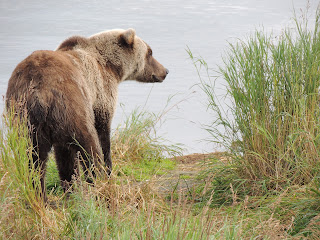Photo: (c) Jamie K. Reaser
Bear
It’s not my track,
I say, seeing
The ball of the foot and the wide heel
And the naily, untrimmed
Toes. And I say again,
For emphasis,
To no one but myself, since no one is
With me. This is
Not my track, and this is an extremely
Large foot, I wonder
How large a body must be to make
Such a track, I am beginning to make
Bad jokes .I have read probably
A hundred narratives where someone saw
Just what I am seeing. Various things
Happened next. A fairly long list, I won’t
Go into it. But not one of them told
What happened next-I mean, before whatever happens-
How the distances light up, how the clouds
Are the most lovely shapes you have ever seen, how
The wild flowers at your feet begin distilling a fragrances
Different, and sweeter than any you ever stood upon-how
Every leaf on the whole mountain is aflutter.
~ Mary Oliver
PRACTICE
- Dress appropriately to be out-of-doors for at least an hour.
- Bring an adequate supply of water, pen, and journal.
- Select a location where you can both walk on a nature trail and step off the trail to wander in the surrounding area (Note: it is against the rules in some local parks (etc.) to leave the trail. Please respect local provisions meant to protect you and the natural environment).
- Recommendation: Let someone know where you are going and when you plan to return.
- Upon arrival, practice “Connecting with Nature” (posted January 8, 2013), or any other activity that will enable you to fully tune into the landscape.
- Spend at least a quarter of your time walking along the nature trail. Notice what your attention is drawn to and what thoughts and emotions are present.
- Journal your observations of both the inner and outer landscape.
- Wander a bit further on the trail and then select a location to wander off the trail into the woods. Notice how your thoughts and emotions shift.
- As you walk forward “introduce” yourself to the
natural landmarks and take mental note of their individual characteristics
- Proceed to explore this natural area for as long as time permits, taking time to journal your observations and insights when you are inspired to do so.
- Return along the same path, “acknowledging” each of your landscape features as your make your way back to the trail. What do you notice about each of them and about yourself as your return?
- Once back at the trail, journal your observations.
- Repeat the practice often, each time allowing yourself to go a little further from the trail and/or into an area that you have not explored previously. Notice how your ability to become increasingly "intimate" with the natural world influences your relationship with people.





